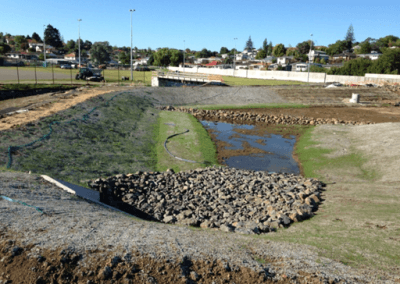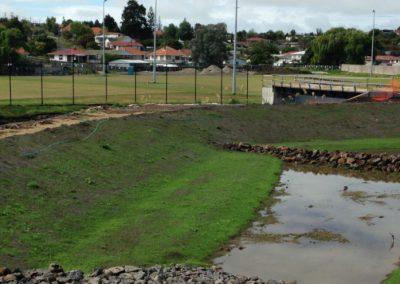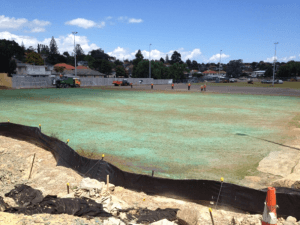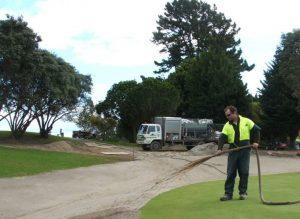Erosion Control
Soil and surface stabilisation practicesHydroseeding
What, why, when and issues to look out for
What
Hydroseeding means applying seed, fertiliser and paper or wood pulp with water in the form of a slurry (which is a fine, semi-liquid mixture). The slurry is sprayed over an area, to apply the seed.
It is not an instant stabilisation practice, but the slurry does provide limited protection from raindrop impact for a short time until the grass is established.
Why
Hydroseeding establishes vegetation quickly. It is especially useful for steep and/or inaccessible areas, or surfaces without much topsoil.
When
Hydroseeding is mainly used in the following situations:
- Important areas that need quicker germination and stabilisation than by conventional hand seeding, eg steep slopes, batters (a gradual backwards slope) and exposed areas near watercourses
- Areas that may be difficult to establish by conventional sowing methods, eg because they are steep or difficult to access
- Around or on runoff diversion channels/bunds, when it’s important to establish vegetation cover quickly before introducing water flow.
-

Recently applied hydroseed on a stormwater wetland (Source: SouthernSkies).
-

One week later, grass starting to take well (Source: SouthernSkies).
Issues to look out for

Sports-field being hydroseeded. Sediment control remains installed until an 80% grass strike has established (Source: SouthernSkies).
Hydroseeding has the following limitations:
- It is applied with specialised equipment. As a result, there is a reliance on experienced contractors and local knowledge to make sure that the seed mix is appropriate for the site and conditions. Plan ahead and confirm your contractors well ahead of time.
- Newly established hydroseed can be mobilised (moved) by intense rainfall
- Until the vegetation has established, a hydroseeded area is not considered a stabilised surface.
- You still need to water areas where hydroseeding has been applied. Do this carefully. Work out how much to irrigate hydroseeded areas to prevent over-saturation. Use a gentle spray irrigator or a K-line rather than a gun so that you don’t blast the hydroseed away.
Design essentials
There are different types of hydroseed mixes. They use different combinations of soil ameliorants (substances that aid plant growth), paper or wood pulp. Sometimes a binder is used to help seeds adhere to the soil surface.
Hydroseed mixes vary greatly depending on the site-specific conditions and the outcome required. You need to consult with a hydroseeding contractor about your particular job, so that the seed mixes and application rate will achieve the required outcomes.
As with other methods of seeding, the area is not considered stabilised until at least 80% density of grass cover has been established.
Construction, operation and maintenance
When constructing and operating hydroseeding
- Cover exposed subsoil (especially loess) slopes with compost or topsoil. Hydroseeding straight onto subsoil may result in poor ongoing survival of the grass and low erosion control.
- Consult with a hydroseeding contractor to make sure that the seed mix and application rate are right for your project.
When maintaining hydroseeding
- Heavy rainfall can wash new hydroseeding away before the vegetation is fully established. This especially happens on smoother hard surfaces and overland flow paths. If the grass hasn’t established well enough, you will need to reapply hydroseed and/or consider other stabilisation techniques.
- Apply additional fertiliser dosing at the ratio of 15:10:10 (N:P:K) approximately 6 to 12 weeks after initial hydroseeding or as required.
- Water hydroseeded areas to promote growth, but take care to avoid washing the hydroseed away.
- Protect all re-vegetated areas from construction traffic and other site activities like the installation of drainage and utility services.
